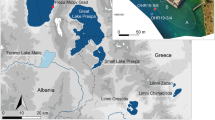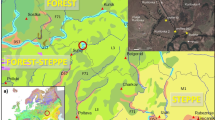Abstract
Multiproxy analysis (pollen, diatom, charcoal) on a 6 m core from Lago Verde (Sierra de Los Tuxtlas), shows evidences of environmental changes and human impact on the evergreen rainforest on the tropical lowlands of eastern Mexico during the last ca. 2,800 years. Prehistoric human occupation is recorded since the late Formative throughout the middle Classic (250 b.c.–ca. a.d. 800) by the presence of maize pollen, a low abundance of tropical arboreal taxa and a high abundance of herbaceous pollen and charcoal particles. This occurred under a scenario of very low lake levels from which dry conditions are inferred based on the dominance of aerophilous and periphytic diatom taxa. After ca. a.d. 800 the site was abandoned and forest regeneration started, at the same time higher lake levels, an indication of more humid conditions, were established. In the absence of human disturbance, tropical forest regeneration was rapid (ca. 200 years). Fluctuations in pollen composition during times of low human population at the site are related to climate variability, with the highest tropical forest diversity and lake levels recorded during the Little Ice Age. Modern human impact is also recorded and compared with the prehistoric deforestation event. Comparison with palaeoecological records from Yucatan and the highlands of central Mexico offers a Mesoamerican perspective of climatic variability giving evidence that the late Formative and early to middle Classic demographic expansion occurred under a scenario of climates dryer than present, with the Postclassic characterized by moister conditions. The end of the Classic (ca. a.d. 800–1000) is identified as a period of rapid climate change which marks one of the most important cultural transitions in Mesoamerica.




Similar content being viewed by others
References
Alvarez del Castillo C (1977) Estudio ecológico y florístico del cráter del volcán San Martín Tuxtla Tuxtlas, Veracruz. Biótica 2:3–54
Alvarez-Buylla E (1997) Historia natural de especies. Cercopia obtusifolia. In: González-Soriano E, Dirzo R, Vogt R (eds) Historia Natural de Los Tuxtlas. Universidad Nacional Autónoma de México, México, pp 109–114
Andrle RF (1964) A Biogeographical Investigation of the Sierra de Tuxtla in Veracruz, Mexico. Dissertation, Louisiana State University
Brown TA, Farwell GW, Grootes PM, Schmidt FH (1992) Radiocarbon AMS dating pollen extracted peat samples. Radiocarbon 34:550–556
Byrne R, Horn S (1989) Prehistoric agriculture and forest clearance in the Sierra de los Tuxtlas, Veracruz, Mexico. Palynology 13:181–193
Caballero M, Ortega B, Valadéz F, Metcalfe S, Macías J, Sugiura Y (2002) Sta. Cruz Atizapán: a 22-ka lake level record and climatic implications for the late Holocene human occupation in the Upper Lerma Basin, Central Mexico. Palaeogeogr Palaeoclimatol Palaeoecol 186:217–235
Caballero M, Vázquez G, Lozano-García MS, Rodríguez A, Sosa-Nájera S, Ruiz-Fernández C, Ortega-Guerrero B (2006) Present limnological conditions and recent (ca. 340 yr) palaeolimnology of a tropical lake in the Sierra de Los Tuxtlas, Eastern Mexico. J Paleolimnol 35:83–97
Castillo-Campos G, Laborde J (2004) La vegetación. In: Guevara S, Laborde J, Sánchez-Ríos G (eds) Los Tuxtlas, El Paisaje de la Sierra. Unión Europea-Instituto de Ecología, A.C. México, pp 231–265
Curtis JH, Hodell DA, Brenner M (1996) Climate variability on the Yucatan Peninsula (Mexico) during the past 3500 years, and implications for Maya cultural evolution. Quat Res 46:37–47
Dahl-Jensen D, Mosegaard K, Gundestrup N, Clow GD, Johnsen SJ, Hansen AW, Balling N (1998) Past temperatures directly from the Greenland Ice Sheet. Science 282:268–271
Dirzo R, García MC (1992) Rates of deforestation in Los Tuxtlas, a neotropical area in Southeast Mexico. Conserv Biol 6:84–90
Fitzhugh WW, Ward IE (2000) Vikings: the North Atlantic Saga. Smithsonian Books and National Museum of Natural History, Washington
García JA (1835) Eruptionen des Vulkanes von Tuxtla in den Jahren 1664 und 1793. Neues Jahrb. für Mineralogie, Geognosie, Geologie und Petrefaktenkunde, 40–45
Gill RB (2000) The great Maya droughts water, life, and death. University of New Mexico Press, Albuquerque
Goman M, Byrne R (1998) A 5000-year record of agricultural and tropical forest clearance in the Tuxtlas, Veracruz, Mexico. Holocene 8:83–89
González-Soriano E, Dirzo R, Vogt R (1997) Historia Natural de Los Tuxtlas. Universidad Nacional Autónoma de México, México
Grimm EC (1987) CONISS: A FORTRAN program for stratigraphically constrained cluster analysis by the method of incremental sum of squares. Comput Geosci 13:13–35
Grimm EC (1992) TILIA 2 software. Illinois State Museum, Springfield
Guevara S, Laborde J, Sánchez-Ríos G (2004) Los Tuxtlas, El Paisaje de la Sierra. Instituto de Ecología. A.C. y Unión Europea, Xalapa
Haug GH, Günther D, Peterson LC, Sigman KA, Hughen B, Aeschlimann B (2003) Climate and the collapse of the Maya civilization. Science 299:1731–1735
Hodell DA, Curtis JH, Brenner M (1995) Possible role of climate in the collapse of Classic Maya civilization. Nature 375:391–394
Hodell DA, Brenner M, Curtis JH, Guilderson T (2001) Solar forcing of drought frequency in the Maya lowlands. Science 292:1367–1370
Hodell DA, Brenner M, Curtis JH (2005) Terminal classic drought in the northern Maya lowlands inferred from multiple sediment cores in Lake Chichancanab, México. Quat Sci Rev 24:1413–1427
Ibarra-Manríquez G, Sinaca-Colín S (1987) Listados Florísticos de México VII, Estación de Biología Tropical Los Tuxtlas Veracruz. Universidad Nacional Autónoma de México, México
Ibarra-Manríquez G, Sinaca-Colín S (1995) Lista florística de la Estación de Biología Tropical Los Tuxtlas, Veracruz, México. Rev Biol Trop 43:75–115
Ibarra-Manríquez G, Martínez-Ramos M, Dirzo R, Núñez-Farfán J (1997) La Vegetación. In: González-Soriano E, Dirzo R, Vogt R (eds) Historia Natural de Los Tuxtlas. Universidad Nacional Autónoma de México, México, pp 61–85
Komárková J, Tavera R (2003) Steady state of phytoplankton assemblage in the tropical Lake Catemaco (Mexico). Hydrobiologia 503:187–196
Lozano-García MS, Martínez-Hernández E (1990) Palinología de la Estación de Biología Tropical Los Tuxtlas. Parte I. Especies Arbóreas. Publicaciones Especiales No. 3. Instituto de Biología, Universidad Nacional Autónoma de México, México
Lozano-García MS, Ibarra-Manríquez G, Sosa-Nájera S (1995) Palinología de las lianas de la estación de Biología Tropical Los Tuxtlas. Bol Soc Bot de México 57:79–102
Lozano-García MS, Caballero M, Ortega B, Rodríguez A, Sosa S (2007) Tracing the effects of the Little Ice Age in the tropical lowlands of eastern Mesoamerica. Proc Natl Acad Sci 104:16200–16203
Martínez-Ramos M (1997) Astrocaryum mexicanum. In: González-Soriano E, Dirzo R, Vogt R (eds) Historia Natural de Los Tuxtlas. Universidad Nacional Autónoma de México, México, pp 92–97
Martínez-Ramos M, Alvarez-Buylla E (1986) Gap dynamics, seed dispersal and tree recruitment at Los Tuxtlas, Mexico. In: Estrada A, Fleming TH (eds) Frugivores and seed dispersal. Junk Publishers, Dordrecht, pp 323–346
Mayewski PA, Rohling E, Stager C, Karlén K, Maasch K, Meeker LD, Meyerson E, Gasse F, van Kreveld S, Holmgren K, Lee-Thorp J, Rosqvist G, Rack F, Staubwasser M, Schneider R (2004) Holocene climate variability. Quat Res 62:243–255
Metcalfe SE, Street-Perrott FA, Perrot RA, Harkness DD (1991) Paleolimnology of the Upper Lerma Basin, Central Mexico: a record of climatic change and anthropogenic disturbance since 11,600 yr BP. J Paleolimnol 5:197–218
Metcalfe SE, Davies SJ, Braisby JD, Leng MJ, Newton AJ, Terrett NL, O’Hara SL (2007) Long and short-term change in the Pátzcuaro Basin, central México. Palaeogeogr Palaeoclimatol Palaeoecol 247:272–295
Moziño J (1870) La erupción del volcán de San Martín Tuxtla (Veracruz), ocurrida en el año de 1793. Bol Soc Geogr Estad Rep México 2:62–70
Nelson SA, González-Caver E (1992) Geology and K-Ar dating of the Tuxtla Volcanic Field, Veracruz, Mexico. Bull Volcanol 55:85–96
Ortega-Guerrero B, Caballero M, Lozano-García MS, Vilaclara G, Rodríguez A (2006) Rock magnetic and geochemical proxies for iron mineral diagenesis in a tropical lake: Lago Verde, Los Tuxtlas, East-Central Mexico. Earth Planet Sci Lett 250:444–458
Pool CA, Ohnersorgen MA (2003) Archaeological survey and settlement at Tres Zapotes. In: Pool CA (ed) Settlement archaeology and political economy at Tres Zapotes, Veracruz, Mexico, monographs series 50. The Cotsen Institute of Archaeology, University of California, Los Angeles, pp 7–31
Pope KO, Pohl MED, Jones JG, Lentz DL, von Nagy C, Vega FJ, Quitmyer IR (2001) Origin and environmental setting of ancient agriculture in the lowlands of Mesoamerica. Science 292:1370–1372
Reimer PJ, Baillie MGL, Bard E, Bayliss A, Beck JW, Bertrand CJH, Blackwell PG, Buck CE, Burr GS, Cutler KB, Damon PE, Edwards RL, Fairbanks RG, Friedrich M, Guilderson TP, Hogg AG, Hughen KA, Kromer B, McCormac FG, Manning SW, Ramsey CB, Reimer RW, Remmele S, Southon JR, Stuiver M, Talamo S, Taylor FW, van der Plicht J, Weyhenmeyer CE (2004) IntCal04 terrestrial radiocarbon age calibration, 26–0 ka BP. Radiocarbon 46:1029–1058
Rheinhardt BK (1991) Volcanology of the younger volcanic sequence and volcanic hazards study of the Tuxtla volcanic field, Veracruz, Mexico. Dissertation, Tulane University
Santley RR, Arnold PJ III (1996) Prehispanic settlement patterns in the Tuxtla mountains, southern Veracruz, Mexico. J Field Archaeol 23:225–249
Santley RR, Nelson A, Reinhardt BK, Pool AC, Arnold PJ III (2000) When the day turned to night. In: Bawden G, Reycraft MR (eds) Environmental disaster and the archaeology of human response. Maxwell Museum of Anthropology, Anthropological paper no. 7, pp 143–162
Sluyter A (1997) Regional, Holocene records of the human dimension of global change: sea-level and land-use change in prehistoric Mexico. Global Planet Change 14:127–146
Soto M, Gama L (1997) Climas. In: Dirzo R, González-Soriano E, Vogt R (eds) Historia Natural de Los Tuxtlas. Universidad Nacional Autónoma de México, México, pp 7–23
Sousa M (1968) Ecología de las leguminosas de Los Tuxtlas, Veracruz. Anales Inst Biol Univ Nac Autón México Ser Bot 39(1):121–160
Stuiver M, Reimer PJ, Reimer RW (2005) CALIB 5.0. [WWW program and documentation]
Vázquez G, Favila ME, Madrigal R, Montes del Olmo C, Baltanás A, Bravo MA (2004) Limnology of crater lakes in Los Tuxtlas, Mexico. Hydrobiologia 523:59–70
Whitlock C, Larsen C (2001) Charcoal as fire proxy. In: Smol JP, Birks HJB, Last WM (eds) Tracking environmental change using lake sediments. Vol 3. Terrestrial, algal and siliceous indicators. Kluwer, Dordrecht, pp 75–97
Acknowledgments
We thank Angel Ramirez, Antonio González Rodolfo Robledo, Teodoro Hernández and Gloria Vilaclara for technical support and the staff members of the Limnological Research Center, University of Minnesota, for their assistance with the initial description of cores and TC/TOC analyses. This study was funded by CONACyT grant G28528-T and UNAM-DGAPA grant IN107902.
Author information
Authors and Affiliations
Corresponding author
Additional information
Communicated by L. Newsom.
Rights and permissions
About this article
Cite this article
Lozano-García, S., Caballero, M., Ortega, B. et al. Late Holocene palaeoecology of Lago Verde: evidence of human impact and climate change in the northern limit of the neotropics during the late formative and classic periods. Veget Hist Archaeobot 19, 177–190 (2010). https://doi.org/10.1007/s00334-010-0240-8
Received:
Accepted:
Published:
Issue Date:
DOI: https://doi.org/10.1007/s00334-010-0240-8




